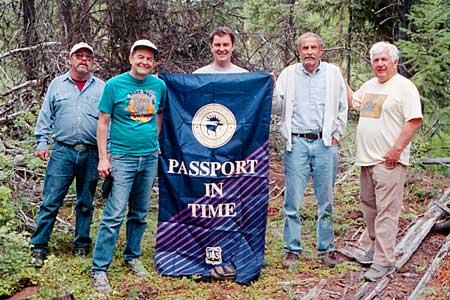J Neils Lumber - Passport in Time
Main menu:
Previous Projects > States M-R
J. Neils Lumber Company Camp 7
Kootenai National Forest, Montana, 2001
by Mark J. White, FS Archaeologist
Last July and August, PIT volunteers and FS archaeologists worked together to document the archaeological remains of Camp 7 of the J. Neils Lumber Company, a short-term logging camp in use from June through December 1919. The camp was for single men or men without their families. Camp 7 was the last of the railroad logging camps in McMillan Draw, located about 8 miles southwest of Libby, Montana. The area had been logged by the Libby Lumber Company from 1915 through 1918. In January 1919, the J. Neils Lumber Company purchased Libby’s mill and lands, which included McMillan Draw. Camp 7 was apparently set up to harvest stands of ponderosa pine, Douglas fir, and western larch in the area. The camp is located in a stand of lodgepole pine—somewhat of an anomaly in McMillan Draw, except in this wetter area.
 Working on the project with volunteers Tamra White, Russ Hudson (forester and former employee of J. Neils Lumber Company and other lumber companies), Don Peterson, Gary Roberts, Brad Baeth, and Jeff Gruber were FS Archaeologists Mark J. White and Michael J. Kroschel of the Libby Ranger District and Cindy Hemry of the Rexford Ranger District. Before beginning site documentation on the first day, volunteers participated in a tailgate safety briefing and a session on the site’s cultural and natural history. Mark shared interesting information he had learned from archival research and from an interview with George Heath, who drove a team of horses and hauled logs on a chute for the J. Neils Lumber Company at nearby Camp 6 when he was 15 years old. Then, while Michael used aGPS unit to map buildings, features, and logging railroad lines, Mark and Cindy worked with volunteers to record features and artifacts. A picture of the logging camp began to emerge—the structural remains of buildings where the workers ate and slept, a cellar where perishable foods might have been stored, and outhouse pits. Other features were related to the logging operation itself—berms, a steam donkey skidding ditch, railroad grades and spurs, and refuse dumps. Hundred of sanitary cans of all sizes and shapes and some hole-in-top cans were noted in the logging camp area.
Working on the project with volunteers Tamra White, Russ Hudson (forester and former employee of J. Neils Lumber Company and other lumber companies), Don Peterson, Gary Roberts, Brad Baeth, and Jeff Gruber were FS Archaeologists Mark J. White and Michael J. Kroschel of the Libby Ranger District and Cindy Hemry of the Rexford Ranger District. Before beginning site documentation on the first day, volunteers participated in a tailgate safety briefing and a session on the site’s cultural and natural history. Mark shared interesting information he had learned from archival research and from an interview with George Heath, who drove a team of horses and hauled logs on a chute for the J. Neils Lumber Company at nearby Camp 6 when he was 15 years old. Then, while Michael used aGPS unit to map buildings, features, and logging railroad lines, Mark and Cindy worked with volunteers to record features and artifacts. A picture of the logging camp began to emerge—the structural remains of buildings where the workers ate and slept, a cellar where perishable foods might have been stored, and outhouse pits. Other features were related to the logging operation itself—berms, a steam donkey skidding ditch, railroad grades and spurs, and refuse dumps. Hundred of sanitary cans of all sizes and shapes and some hole-in-top cans were noted in the logging camp area.The next day included a minicourse on the history of logging in Montana. The volunteers joined participants in a local Elderhostel program and students from the Lincoln County Campus of Flathead Community College for the evening lecture, which provided background for the following day’s tour of the site. Thirty visitors toured the site, including 11 members of the George Neils family. George Neils—son of the J. Neils Lumber Company founder, Julius Neils—was the woods manager of the upper McMillan Draw logging operation of the J. Neils Lumber Company in 1919.
On the last day of the session, additional features were recorded at Camp 7, including a southwest-trending logging railroad grade that we hadn’t noticed before. We walked to the end of the grade, where we found the setting for the tow donkey, a steam engine that used its cable like a winch to drag the coal-fired Shay locomotive and empty railroad cars up the tow hill at a 10 percent grade and lower the railroad cars loaded with logs (14 cars per day in the summer and fall of 1919). There was a small camp associated with the tow donkey as well as donkey engine settings for logging adjacent to the railroad grade. Features such as ties with spikes, rotted trestles, railroad cuts, and various artifacts, including cable, broken couplers, donkey engine gears, and logging cable, were noted in the upper railroad logging works.
So much to do and so little time... We were able to record the main logging camp site during this PIT project, but additional features associated with the tow grade will be recorded later. The project has contributed significantly to our knowledge of railroad-logging activities and technology in McMillan Draw and on the forest.